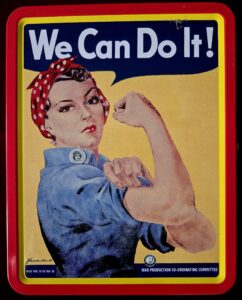 My new novel Ink and Intrigue at Ivy Tree Inn, takes place in 1958, and my main character, Ariadne Winter, faces hurdles when it comes to workplace equality. This week, I had the pleasure of writing an article for Reader’s Entertainment Magazine. It highlights the gender bias and struggles women faced and continue to face in the workforce. Specifically detailing their forced exodus from the workforce after WWII. Below is an excerpt from the article.
My new novel Ink and Intrigue at Ivy Tree Inn, takes place in 1958, and my main character, Ariadne Winter, faces hurdles when it comes to workplace equality. This week, I had the pleasure of writing an article for Reader’s Entertainment Magazine. It highlights the gender bias and struggles women faced and continue to face in the workforce. Specifically detailing their forced exodus from the workforce after WWII. Below is an excerpt from the article.
Thanks Rosie, Now it’s Time to Return Home
World War II marked a significant turning point in the role of women in the workforce, both in the United States and around the world. Prior to the war, women were largely confined to domestic roles or certain “feminine” occupations such as teaching, nursing, and secretarial work. However, the unprecedented demand for labor during the war, combined with the absence of men who were deployed to fight, created new opportunities for women to enter industries that had been traditionally dominated by men. Yet, this period of female empowerment was short-lived, as the end of the war saw many women pushed out of their jobs to make way for returning soldiers. Since then, women have faced an uphill battle for workplace equality, especially in terms of pay and promotions.
Women’s Entry into the Workforce During WWII
 With the onset of World War II, millions of men left their jobs to serve in the military, creating a critical labor shortage in industries essential to the war effort. This included manufacturing, transportation, and agriculture—sectors that had long been male-dominated. The government and private employers launched extensive recruitment campaigns to encourage women to fill these vacancies. One of the most iconic symbols of this effort was “Rosie the Riveter,” the cultural figure representing the capable and patriotic female worker, popularized by the “We Can Do It!” poster. Women were called upon to join the workforce, not just as a matter of necessity but as a demonstration of national loyalty.
With the onset of World War II, millions of men left their jobs to serve in the military, creating a critical labor shortage in industries essential to the war effort. This included manufacturing, transportation, and agriculture—sectors that had long been male-dominated. The government and private employers launched extensive recruitment campaigns to encourage women to fill these vacancies. One of the most iconic symbols of this effort was “Rosie the Riveter,” the cultural figure representing the capable and patriotic female worker, popularized by the “We Can Do It!” poster. Women were called upon to join the workforce, not just as a matter of necessity but as a demonstration of national loyalty.
Women responded to the call in large numbers. By 1944, over 6 million women had entered the workforce in the United States alone, bringing the total number of working women to nearly 20 million…
